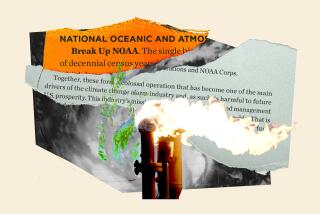Possible Cuts to Laser Budget Worry Experts
- Share via
Some of the nation’s senior nuclear weapons experts are warning that a move in the Senate to kill construction funding for a massive laser complex at Lawrence Livermore National Laboratory will erode confidence in the nation’s nuclear weapons.
The Senate is expected this week to approve an appropriations bill that would delete $146 million for further construction of the laser, known as the National Ignition Facility. The $3.4-billion laser, one of the nation’s largest scientific projects, is about 80% complete.
It is designed to simulate fusion reactions that occur in hydrogen bombs and allow scientists to continue research without actually detonating weapons. The laser has long been described as one of the cornerstones of U.S. efforts to maintain aging nuclear weapons without underground testing, which was stopped in 1992.
But Sen. Pete V. Domenici (R-N.M.), a power broker on energy issues, pushed through an appropriations measure last week to eliminate $146 million for the laser’s construction. The bill would stop construction of the laser, although it does provide money for continued research. So far, the U.S. has spent $2.8 billion on the project.
Domenici is in an influential political position this year, navigating the Bush administration’s energy legislation through the Senate. He can use the laser facility as political leverage and is protecting projects in New Mexico at Los Alamos National Laboratory, the nation’s other nuclear weapons design center, congressional staffers who support the laser facility said.
The bill could come up for a full Senate vote as early as Wednesday. The funding is unlikely to be restored on the Senate floor, although supporters hope the money can be put back in a later House-Senate conference committee.
The political effort to kill the project has stunned Livermore officials, who say the laser is crucial to maintaining the reliability of hydrogen bombs, most of which are now decades old. The last U.S. nuclear weapon was built in 1989, although the Energy Department in 2003 regained the ability to manufacture plutonium parts.
Hydrogen bombs contain tens of thousands of complex parts, packed in a radioactive environment with the high explosives and sensitive electronics. To ensure that they would work properly, the U.S. initiated a multibillion-dollar program of scientific research in the mid-1990s known as “stockpile stewardship.”
George Miller, a veteran nuclear weapons designer at Livermore, said the laser’s absence would lead to an erosion in the confidence that the weapons are reliable and safe.
“There are very serious implications to canceling this project,” said Miller, the associate director of the Bay Area lab. “You have to seriously question the commitment to maintain nuclear weapons.”
Linton Brooks, head of the National Nuclear Security Administration, the agency that oversees the nuclear weapons program, strongly endorsed those concerns in an interview Thursday.
The laser project “is very important because it provides a tool that we can’t get in any other way,” Brooks said. “There is data that we simply do not know how to get except from the National Ignition Facility. So by definition, that will weaken our confidence. That is why the country has spent $2.8 billion so far on this and why we ought to get on with completing the project.”
The facility would focus 192 laser beams on a small pellet of hydrogen for a fraction of a second, igniting a fusion reaction inside a massive test chamber. So far, scientists have installed just four of the 192 beams, although the structure and much of the equipment are in place.
The reliability of nuclear weapons involves not only whether aging will prevent them from exploding, but more important, whether they will detonate with their designed nuclear yields. A risk of aging weapons is that they will produce only a small atomic blast and not a massive hydrogen explosion.
The potential strength of an explosion is critical to nuclear deterrence. Though even a weak explosion can destroy cities, only powerful hydrogen blasts can damage hardened missile silos in use now by Russia and China, and possibly in the future in North Korea, India, Pakistan and Iran.
If there were such a loss of confidence, it would no doubt lead to pressure for new underground testing, said John Pike, a defense expert at GlobalSecurity.org., a think tank in Alexandria, Va. Brooks said the Bush administration fully supported the current moratorium on underground testing and had no intention of seeking a resumption of testing.
Although Domenici has cut funding for the laser project in past years only to have the moves later reversed, this is the first time he has tried to stop construction. Though his bill cuts funding by $146 million, it provides $314 million for limited research.
In a statement to The Times, Domenici defended the cuts to the laser’s budget, saying he was committed to a strong science-based program, but that “unfortunately, neither this budget nor the long-term budgetary outlook is consistent with this objective.”
Domenici has also chastised cost overruns in the program. Indeed, the laser originally was projected to cost less than $1 billion. It ran into earlier technical problems that more than tripled its cost, though in recent years the program has received good reviews from outside analysts.
In November, a review by the Defense Science Board concluded that the project was “well managed and on track” and would provide answers to “the most important questions in weapons physics.” Nonetheless, the board also concluded that the technical risks in the project remained high.
Domenici has criticized Livermore in the past, while defending the Los Alamos nuclear facility in New Mexico. Both labs are managed by the University of California, whose contract for Los Alamos is coming up for competition for the first time since World War II.
Sen. Dianne Feinstein (D-Calif.) has supported the laser project in the past, but it is unlikely she would offer an amendment to restore funding, a member of her staff said. Rather, a fight for the funding would occur in a conference committee.
Rep. Jerry Lewis (R-Redlands), who this year became chairman of the House Appropriations Committee, has been a strong supporter of the project. A Lewis spokesman said he intended to “vigorously contest” the Senate action on the laser.
More to Read
Sign up for Essential California
The most important California stories and recommendations in your inbox every morning.
You may occasionally receive promotional content from the Los Angeles Times.











